Analysis of Buyer-Supplier Relationship in Commercial Management
VerifiedAdded on 2021/04/21
|14
|4523
|434
Report
AI Summary
This report delves into the multifaceted dimensions of buyer and supplier relationships within the context of budget and commercial management. It examines the evolution of these relationships through five distinct stages: partnership of convenience, towards partnership, maintaining partnership, locked-in partnership, and ending partnership. The report further analyzes current and future business trends, emphasizing the importance of procurement and acquisition management, along with strategies for materials and resources management. A key focus is on the contractual and legal frameworks that govern buyer-supplier interactions, including contracting, tendering, and the nuances of negotiation processes. The report underscores the significance of research, alternative considerations, and establishing bargaining ranges to achieve successful contract negotiations. The conclusion highlights the critical need for continuous innovation and strong buyer-supplier relationships in a competitive commercial environment, providing valuable insights for businesses aiming to enhance their market share and profitability.
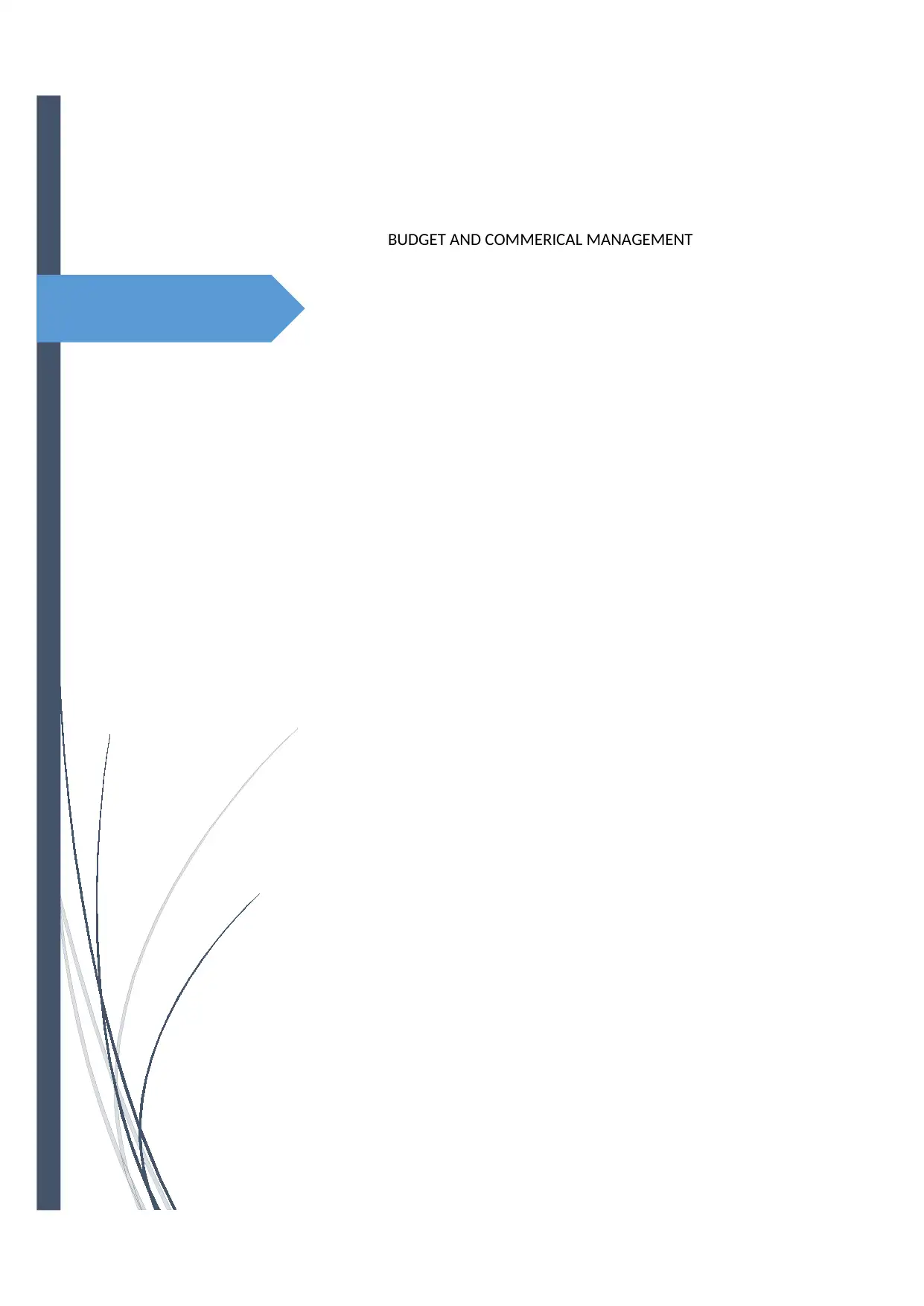
BUDGET AND COMMERICAL MANAGEMENT
Paraphrase This Document
Need a fresh take? Get an instant paraphrase of this document with our AI Paraphraser
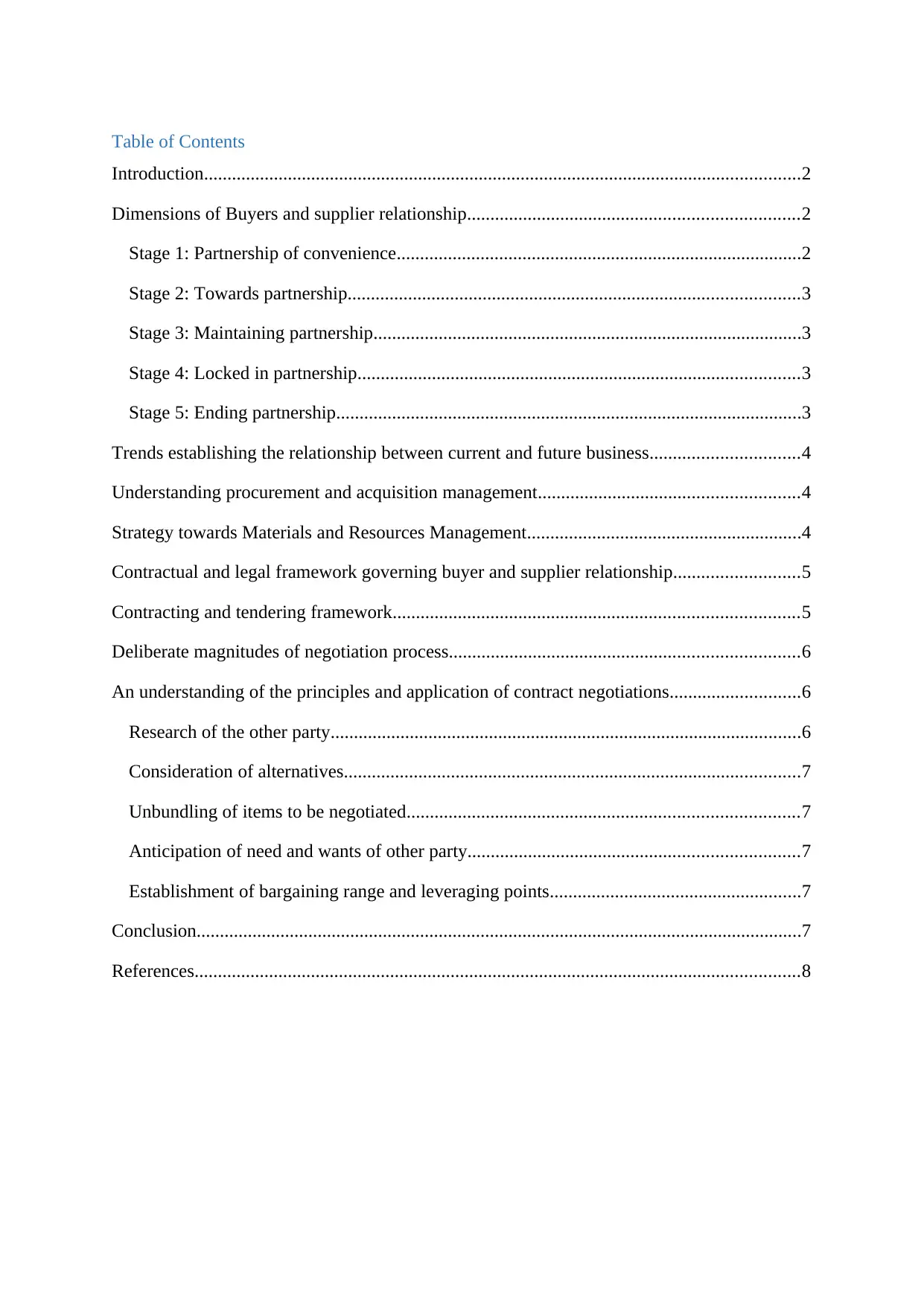
Table of Contents
Introduction................................................................................................................................2
Dimensions of Buyers and supplier relationship.......................................................................2
Stage 1: Partnership of convenience.......................................................................................2
Stage 2: Towards partnership.................................................................................................3
Stage 3: Maintaining partnership............................................................................................3
Stage 4: Locked in partnership...............................................................................................3
Stage 5: Ending partnership....................................................................................................3
Trends establishing the relationship between current and future business................................4
Understanding procurement and acquisition management........................................................4
Strategy towards Materials and Resources Management...........................................................4
Contractual and legal framework governing buyer and supplier relationship...........................5
Contracting and tendering framework.......................................................................................5
Deliberate magnitudes of negotiation process...........................................................................6
An understanding of the principles and application of contract negotiations............................6
Research of the other party.....................................................................................................6
Consideration of alternatives..................................................................................................7
Unbundling of items to be negotiated....................................................................................7
Anticipation of need and wants of other party.......................................................................7
Establishment of bargaining range and leveraging points......................................................7
Conclusion..................................................................................................................................7
References..................................................................................................................................8
Introduction................................................................................................................................2
Dimensions of Buyers and supplier relationship.......................................................................2
Stage 1: Partnership of convenience.......................................................................................2
Stage 2: Towards partnership.................................................................................................3
Stage 3: Maintaining partnership............................................................................................3
Stage 4: Locked in partnership...............................................................................................3
Stage 5: Ending partnership....................................................................................................3
Trends establishing the relationship between current and future business................................4
Understanding procurement and acquisition management........................................................4
Strategy towards Materials and Resources Management...........................................................4
Contractual and legal framework governing buyer and supplier relationship...........................5
Contracting and tendering framework.......................................................................................5
Deliberate magnitudes of negotiation process...........................................................................6
An understanding of the principles and application of contract negotiations............................6
Research of the other party.....................................................................................................6
Consideration of alternatives..................................................................................................7
Unbundling of items to be negotiated....................................................................................7
Anticipation of need and wants of other party.......................................................................7
Establishment of bargaining range and leveraging points......................................................7
Conclusion..................................................................................................................................7
References..................................................................................................................................8
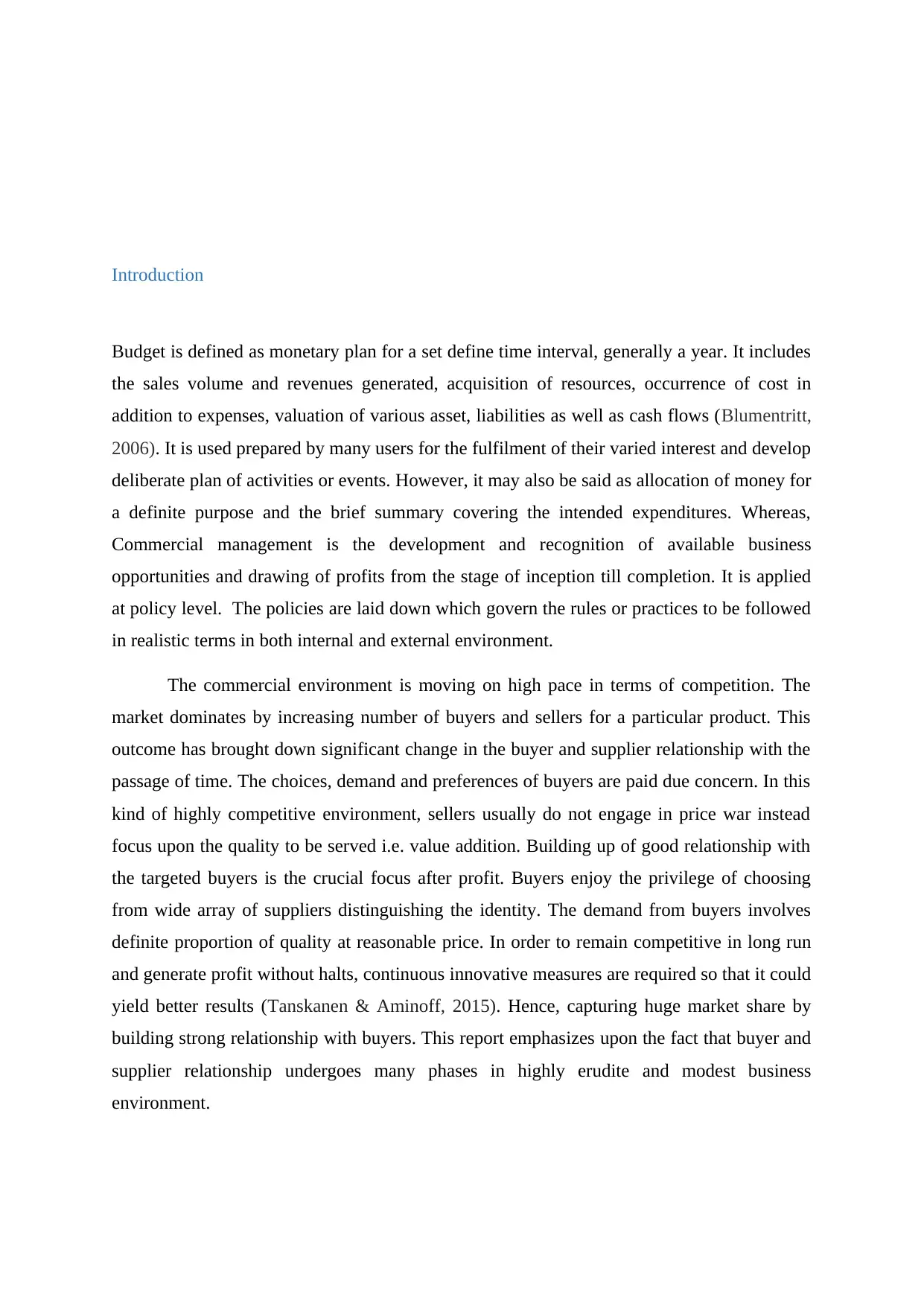
Introduction
Budget is defined as monetary plan for a set define time interval, generally a year. It includes
the sales volume and revenues generated, acquisition of resources, occurrence of cost in
addition to expenses, valuation of various asset, liabilities as well as cash flows (Blumentritt,
2006). It is used prepared by many users for the fulfilment of their varied interest and develop
deliberate plan of activities or events. However, it may also be said as allocation of money for
a definite purpose and the brief summary covering the intended expenditures. Whereas,
Commercial management is the development and recognition of available business
opportunities and drawing of profits from the stage of inception till completion. It is applied
at policy level. The policies are laid down which govern the rules or practices to be followed
in realistic terms in both internal and external environment.
The commercial environment is moving on high pace in terms of competition. The
market dominates by increasing number of buyers and sellers for a particular product. This
outcome has brought down significant change in the buyer and supplier relationship with the
passage of time. The choices, demand and preferences of buyers are paid due concern. In this
kind of highly competitive environment, sellers usually do not engage in price war instead
focus upon the quality to be served i.e. value addition. Building up of good relationship with
the targeted buyers is the crucial focus after profit. Buyers enjoy the privilege of choosing
from wide array of suppliers distinguishing the identity. The demand from buyers involves
definite proportion of quality at reasonable price. In order to remain competitive in long run
and generate profit without halts, continuous innovative measures are required so that it could
yield better results (Tanskanen & Aminoff, 2015). Hence, capturing huge market share by
building strong relationship with buyers. This report emphasizes upon the fact that buyer and
supplier relationship undergoes many phases in highly erudite and modest business
environment.
Budget is defined as monetary plan for a set define time interval, generally a year. It includes
the sales volume and revenues generated, acquisition of resources, occurrence of cost in
addition to expenses, valuation of various asset, liabilities as well as cash flows (Blumentritt,
2006). It is used prepared by many users for the fulfilment of their varied interest and develop
deliberate plan of activities or events. However, it may also be said as allocation of money for
a definite purpose and the brief summary covering the intended expenditures. Whereas,
Commercial management is the development and recognition of available business
opportunities and drawing of profits from the stage of inception till completion. It is applied
at policy level. The policies are laid down which govern the rules or practices to be followed
in realistic terms in both internal and external environment.
The commercial environment is moving on high pace in terms of competition. The
market dominates by increasing number of buyers and sellers for a particular product. This
outcome has brought down significant change in the buyer and supplier relationship with the
passage of time. The choices, demand and preferences of buyers are paid due concern. In this
kind of highly competitive environment, sellers usually do not engage in price war instead
focus upon the quality to be served i.e. value addition. Building up of good relationship with
the targeted buyers is the crucial focus after profit. Buyers enjoy the privilege of choosing
from wide array of suppliers distinguishing the identity. The demand from buyers involves
definite proportion of quality at reasonable price. In order to remain competitive in long run
and generate profit without halts, continuous innovative measures are required so that it could
yield better results (Tanskanen & Aminoff, 2015). Hence, capturing huge market share by
building strong relationship with buyers. This report emphasizes upon the fact that buyer and
supplier relationship undergoes many phases in highly erudite and modest business
environment.
⊘ This is a preview!⊘
Do you want full access?
Subscribe today to unlock all pages.

Trusted by 1+ million students worldwide
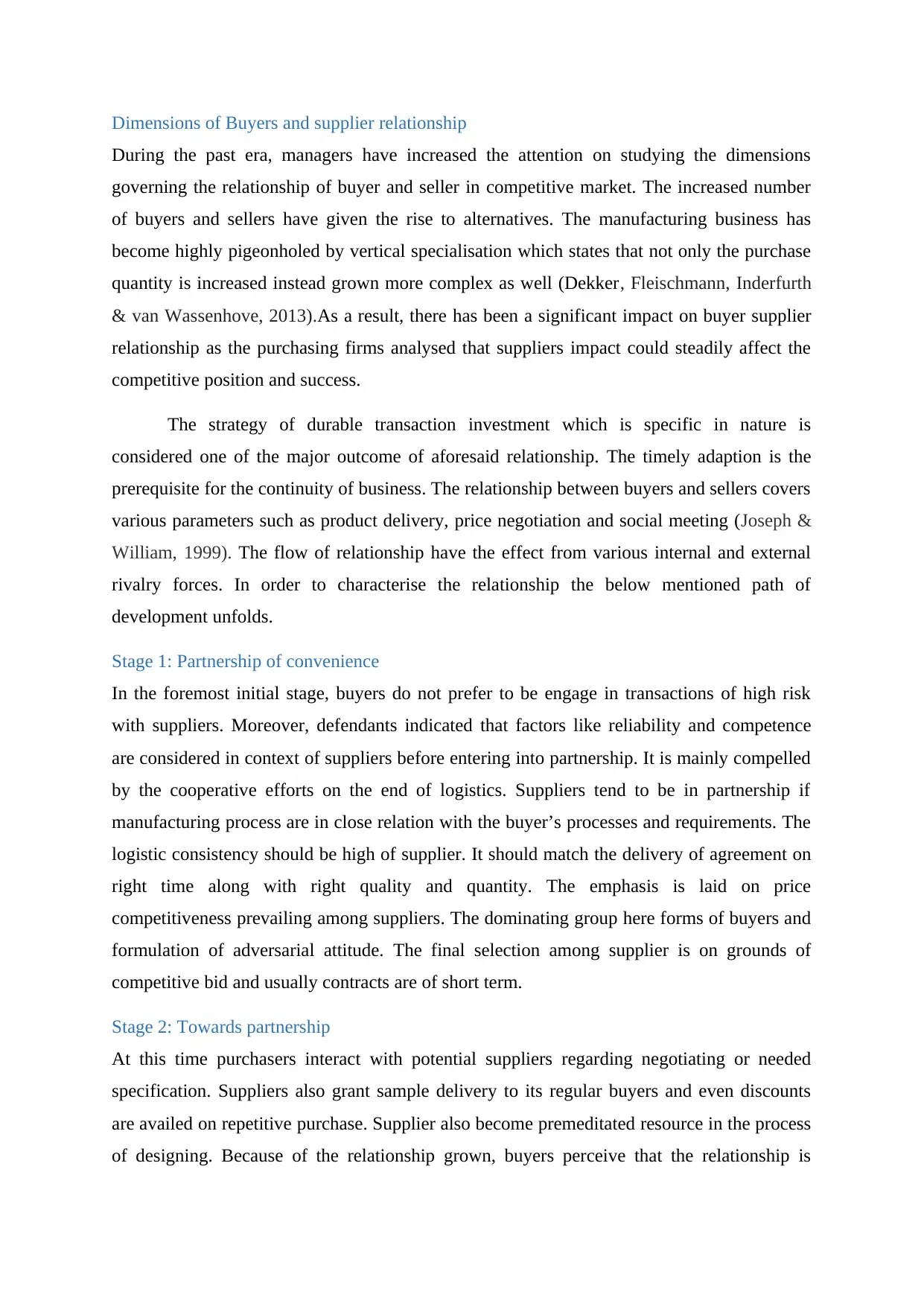
Dimensions of Buyers and supplier relationship
During the past era, managers have increased the attention on studying the dimensions
governing the relationship of buyer and seller in competitive market. The increased number
of buyers and sellers have given the rise to alternatives. The manufacturing business has
become highly pigeonholed by vertical specialisation which states that not only the purchase
quantity is increased instead grown more complex as well (Dekker, Fleischmann, Inderfurth
& van Wassenhove, 2013).As a result, there has been a significant impact on buyer supplier
relationship as the purchasing firms analysed that suppliers impact could steadily affect the
competitive position and success.
The strategy of durable transaction investment which is specific in nature is
considered one of the major outcome of aforesaid relationship. The timely adaption is the
prerequisite for the continuity of business. The relationship between buyers and sellers covers
various parameters such as product delivery, price negotiation and social meeting (Joseph &
William, 1999). The flow of relationship have the effect from various internal and external
rivalry forces. In order to characterise the relationship the below mentioned path of
development unfolds.
Stage 1: Partnership of convenience
In the foremost initial stage, buyers do not prefer to be engage in transactions of high risk
with suppliers. Moreover, defendants indicated that factors like reliability and competence
are considered in context of suppliers before entering into partnership. It is mainly compelled
by the cooperative efforts on the end of logistics. Suppliers tend to be in partnership if
manufacturing process are in close relation with the buyer’s processes and requirements. The
logistic consistency should be high of supplier. It should match the delivery of agreement on
right time along with right quality and quantity. The emphasis is laid on price
competitiveness prevailing among suppliers. The dominating group here forms of buyers and
formulation of adversarial attitude. The final selection among supplier is on grounds of
competitive bid and usually contracts are of short term.
Stage 2: Towards partnership
At this time purchasers interact with potential suppliers regarding negotiating or needed
specification. Suppliers also grant sample delivery to its regular buyers and even discounts
are availed on repetitive purchase. Supplier also become premeditated resource in the process
of designing. Because of the relationship grown, buyers perceive that the relationship is
During the past era, managers have increased the attention on studying the dimensions
governing the relationship of buyer and seller in competitive market. The increased number
of buyers and sellers have given the rise to alternatives. The manufacturing business has
become highly pigeonholed by vertical specialisation which states that not only the purchase
quantity is increased instead grown more complex as well (Dekker, Fleischmann, Inderfurth
& van Wassenhove, 2013).As a result, there has been a significant impact on buyer supplier
relationship as the purchasing firms analysed that suppliers impact could steadily affect the
competitive position and success.
The strategy of durable transaction investment which is specific in nature is
considered one of the major outcome of aforesaid relationship. The timely adaption is the
prerequisite for the continuity of business. The relationship between buyers and sellers covers
various parameters such as product delivery, price negotiation and social meeting (Joseph &
William, 1999). The flow of relationship have the effect from various internal and external
rivalry forces. In order to characterise the relationship the below mentioned path of
development unfolds.
Stage 1: Partnership of convenience
In the foremost initial stage, buyers do not prefer to be engage in transactions of high risk
with suppliers. Moreover, defendants indicated that factors like reliability and competence
are considered in context of suppliers before entering into partnership. It is mainly compelled
by the cooperative efforts on the end of logistics. Suppliers tend to be in partnership if
manufacturing process are in close relation with the buyer’s processes and requirements. The
logistic consistency should be high of supplier. It should match the delivery of agreement on
right time along with right quality and quantity. The emphasis is laid on price
competitiveness prevailing among suppliers. The dominating group here forms of buyers and
formulation of adversarial attitude. The final selection among supplier is on grounds of
competitive bid and usually contracts are of short term.
Stage 2: Towards partnership
At this time purchasers interact with potential suppliers regarding negotiating or needed
specification. Suppliers also grant sample delivery to its regular buyers and even discounts
are availed on repetitive purchase. Supplier also become premeditated resource in the process
of designing. Because of the relationship grown, buyers perceive that the relationship is
Paraphrase This Document
Need a fresh take? Get an instant paraphrase of this document with our AI Paraphraser
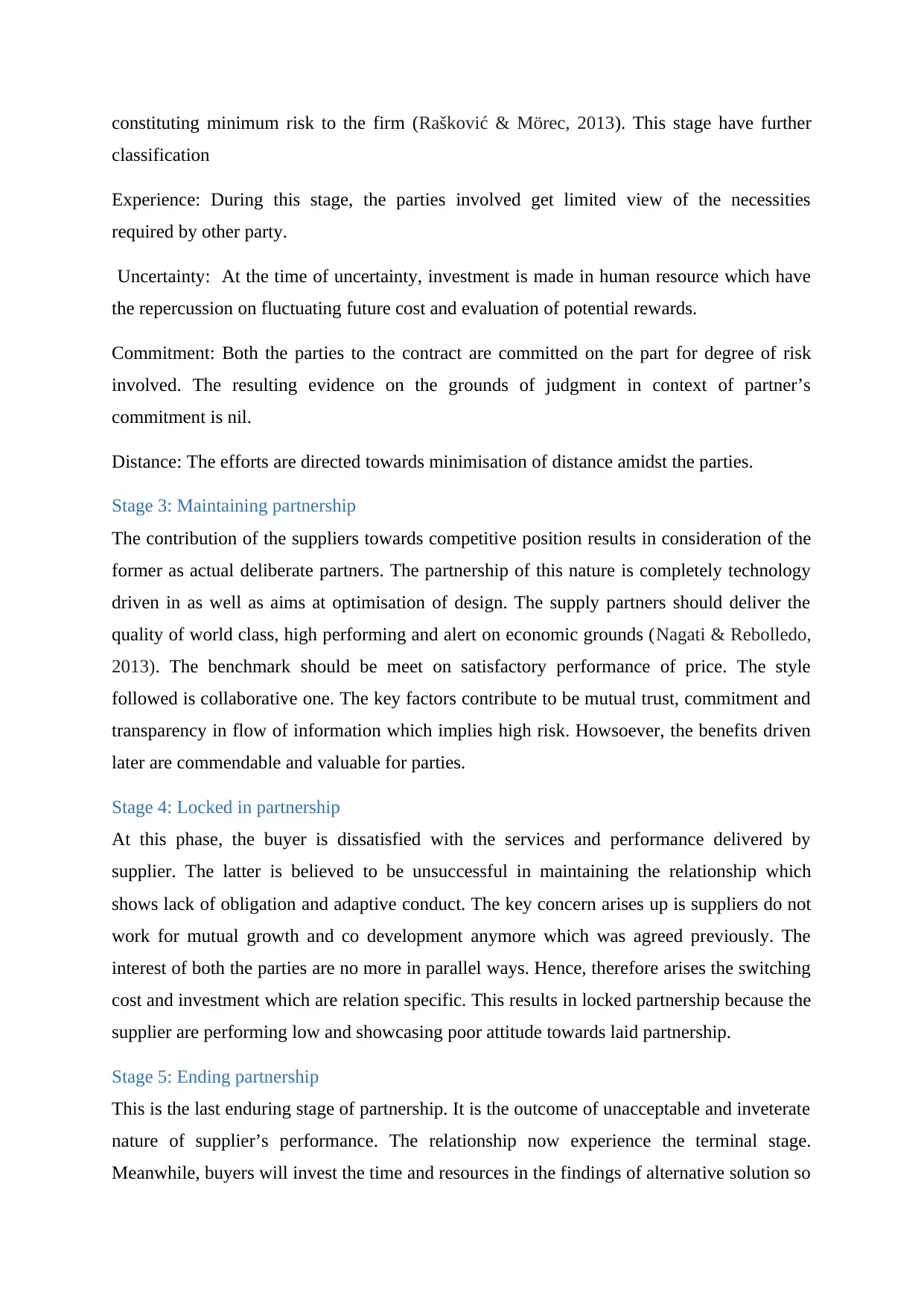
constituting minimum risk to the firm (Rašković & Mörec, 2013). This stage have further
classification
Experience: During this stage, the parties involved get limited view of the necessities
required by other party.
Uncertainty: At the time of uncertainty, investment is made in human resource which have
the repercussion on fluctuating future cost and evaluation of potential rewards.
Commitment: Both the parties to the contract are committed on the part for degree of risk
involved. The resulting evidence on the grounds of judgment in context of partner’s
commitment is nil.
Distance: The efforts are directed towards minimisation of distance amidst the parties.
Stage 3: Maintaining partnership
The contribution of the suppliers towards competitive position results in consideration of the
former as actual deliberate partners. The partnership of this nature is completely technology
driven in as well as aims at optimisation of design. The supply partners should deliver the
quality of world class, high performing and alert on economic grounds (Nagati & Rebolledo,
2013). The benchmark should be meet on satisfactory performance of price. The style
followed is collaborative one. The key factors contribute to be mutual trust, commitment and
transparency in flow of information which implies high risk. Howsoever, the benefits driven
later are commendable and valuable for parties.
Stage 4: Locked in partnership
At this phase, the buyer is dissatisfied with the services and performance delivered by
supplier. The latter is believed to be unsuccessful in maintaining the relationship which
shows lack of obligation and adaptive conduct. The key concern arises up is suppliers do not
work for mutual growth and co development anymore which was agreed previously. The
interest of both the parties are no more in parallel ways. Hence, therefore arises the switching
cost and investment which are relation specific. This results in locked partnership because the
supplier are performing low and showcasing poor attitude towards laid partnership.
Stage 5: Ending partnership
This is the last enduring stage of partnership. It is the outcome of unacceptable and inveterate
nature of supplier’s performance. The relationship now experience the terminal stage.
Meanwhile, buyers will invest the time and resources in the findings of alternative solution so
classification
Experience: During this stage, the parties involved get limited view of the necessities
required by other party.
Uncertainty: At the time of uncertainty, investment is made in human resource which have
the repercussion on fluctuating future cost and evaluation of potential rewards.
Commitment: Both the parties to the contract are committed on the part for degree of risk
involved. The resulting evidence on the grounds of judgment in context of partner’s
commitment is nil.
Distance: The efforts are directed towards minimisation of distance amidst the parties.
Stage 3: Maintaining partnership
The contribution of the suppliers towards competitive position results in consideration of the
former as actual deliberate partners. The partnership of this nature is completely technology
driven in as well as aims at optimisation of design. The supply partners should deliver the
quality of world class, high performing and alert on economic grounds (Nagati & Rebolledo,
2013). The benchmark should be meet on satisfactory performance of price. The style
followed is collaborative one. The key factors contribute to be mutual trust, commitment and
transparency in flow of information which implies high risk. Howsoever, the benefits driven
later are commendable and valuable for parties.
Stage 4: Locked in partnership
At this phase, the buyer is dissatisfied with the services and performance delivered by
supplier. The latter is believed to be unsuccessful in maintaining the relationship which
shows lack of obligation and adaptive conduct. The key concern arises up is suppliers do not
work for mutual growth and co development anymore which was agreed previously. The
interest of both the parties are no more in parallel ways. Hence, therefore arises the switching
cost and investment which are relation specific. This results in locked partnership because the
supplier are performing low and showcasing poor attitude towards laid partnership.
Stage 5: Ending partnership
This is the last enduring stage of partnership. It is the outcome of unacceptable and inveterate
nature of supplier’s performance. The relationship now experience the terminal stage.
Meanwhile, buyers will invest the time and resources in the findings of alternative solution so
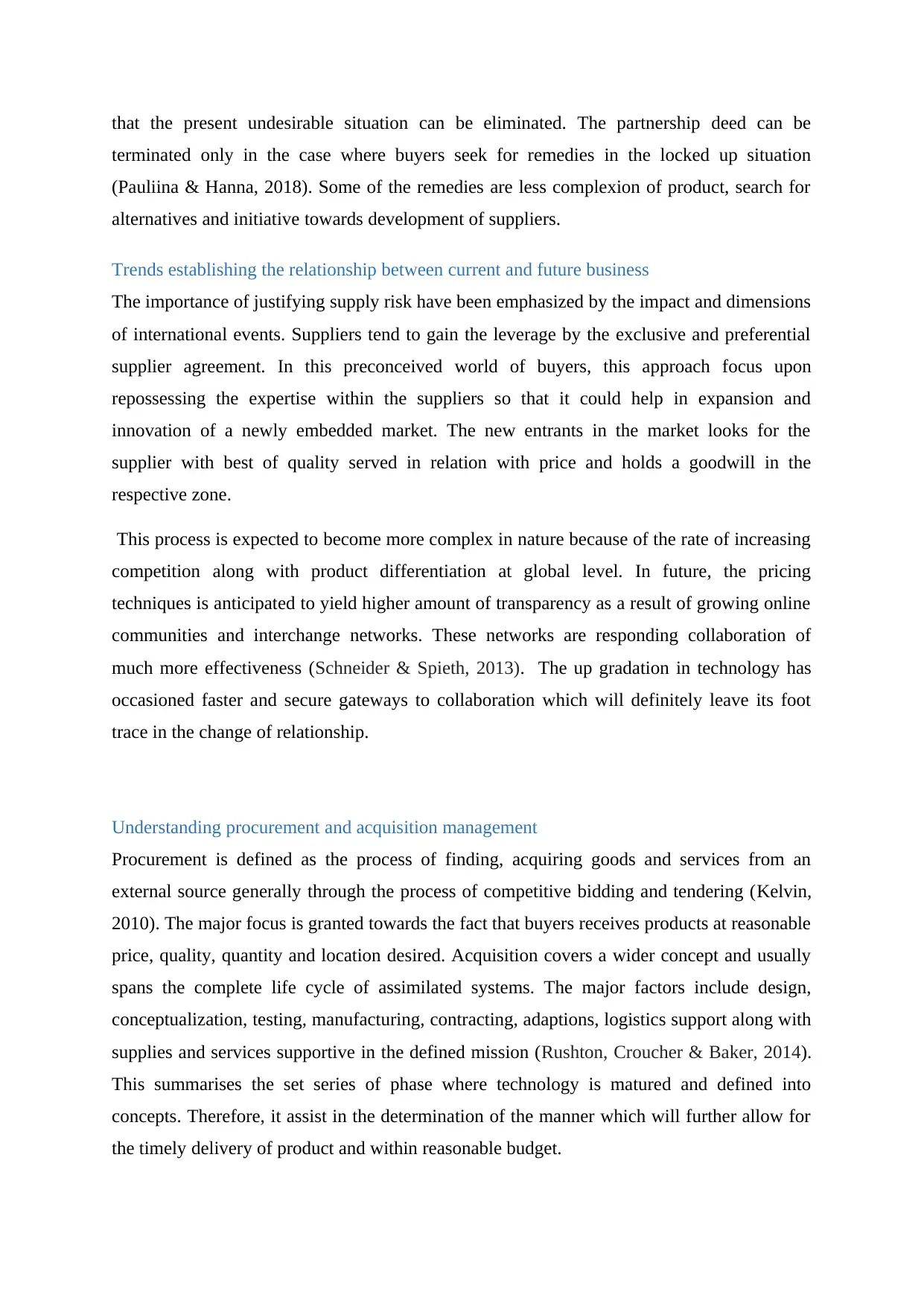
that the present undesirable situation can be eliminated. The partnership deed can be
terminated only in the case where buyers seek for remedies in the locked up situation
(Pauliina & Hanna, 2018). Some of the remedies are less complexion of product, search for
alternatives and initiative towards development of suppliers.
Trends establishing the relationship between current and future business
The importance of justifying supply risk have been emphasized by the impact and dimensions
of international events. Suppliers tend to gain the leverage by the exclusive and preferential
supplier agreement. In this preconceived world of buyers, this approach focus upon
repossessing the expertise within the suppliers so that it could help in expansion and
innovation of a newly embedded market. The new entrants in the market looks for the
supplier with best of quality served in relation with price and holds a goodwill in the
respective zone.
This process is expected to become more complex in nature because of the rate of increasing
competition along with product differentiation at global level. In future, the pricing
techniques is anticipated to yield higher amount of transparency as a result of growing online
communities and interchange networks. These networks are responding collaboration of
much more effectiveness (Schneider & Spieth, 2013). The up gradation in technology has
occasioned faster and secure gateways to collaboration which will definitely leave its foot
trace in the change of relationship.
Understanding procurement and acquisition management
Procurement is defined as the process of finding, acquiring goods and services from an
external source generally through the process of competitive bidding and tendering (Kelvin,
2010). The major focus is granted towards the fact that buyers receives products at reasonable
price, quality, quantity and location desired. Acquisition covers a wider concept and usually
spans the complete life cycle of assimilated systems. The major factors include design,
conceptualization, testing, manufacturing, contracting, adaptions, logistics support along with
supplies and services supportive in the defined mission (Rushton, Croucher & Baker, 2014).
This summarises the set series of phase where technology is matured and defined into
concepts. Therefore, it assist in the determination of the manner which will further allow for
the timely delivery of product and within reasonable budget.
terminated only in the case where buyers seek for remedies in the locked up situation
(Pauliina & Hanna, 2018). Some of the remedies are less complexion of product, search for
alternatives and initiative towards development of suppliers.
Trends establishing the relationship between current and future business
The importance of justifying supply risk have been emphasized by the impact and dimensions
of international events. Suppliers tend to gain the leverage by the exclusive and preferential
supplier agreement. In this preconceived world of buyers, this approach focus upon
repossessing the expertise within the suppliers so that it could help in expansion and
innovation of a newly embedded market. The new entrants in the market looks for the
supplier with best of quality served in relation with price and holds a goodwill in the
respective zone.
This process is expected to become more complex in nature because of the rate of increasing
competition along with product differentiation at global level. In future, the pricing
techniques is anticipated to yield higher amount of transparency as a result of growing online
communities and interchange networks. These networks are responding collaboration of
much more effectiveness (Schneider & Spieth, 2013). The up gradation in technology has
occasioned faster and secure gateways to collaboration which will definitely leave its foot
trace in the change of relationship.
Understanding procurement and acquisition management
Procurement is defined as the process of finding, acquiring goods and services from an
external source generally through the process of competitive bidding and tendering (Kelvin,
2010). The major focus is granted towards the fact that buyers receives products at reasonable
price, quality, quantity and location desired. Acquisition covers a wider concept and usually
spans the complete life cycle of assimilated systems. The major factors include design,
conceptualization, testing, manufacturing, contracting, adaptions, logistics support along with
supplies and services supportive in the defined mission (Rushton, Croucher & Baker, 2014).
This summarises the set series of phase where technology is matured and defined into
concepts. Therefore, it assist in the determination of the manner which will further allow for
the timely delivery of product and within reasonable budget.
⊘ This is a preview!⊘
Do you want full access?
Subscribe today to unlock all pages.

Trusted by 1+ million students worldwide
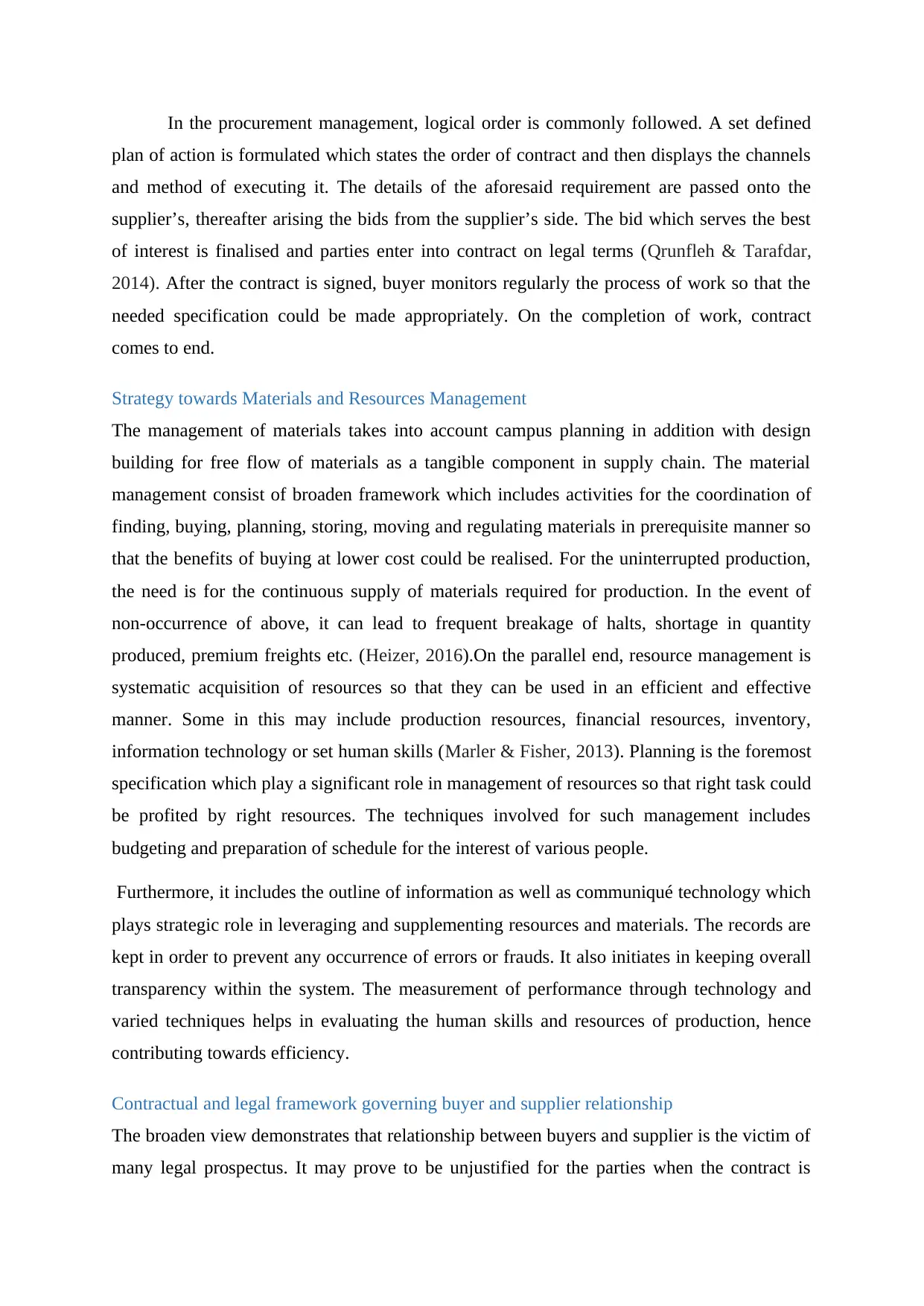
In the procurement management, logical order is commonly followed. A set defined
plan of action is formulated which states the order of contract and then displays the channels
and method of executing it. The details of the aforesaid requirement are passed onto the
supplier’s, thereafter arising the bids from the supplier’s side. The bid which serves the best
of interest is finalised and parties enter into contract on legal terms (Qrunfleh & Tarafdar,
2014). After the contract is signed, buyer monitors regularly the process of work so that the
needed specification could be made appropriately. On the completion of work, contract
comes to end.
Strategy towards Materials and Resources Management
The management of materials takes into account campus planning in addition with design
building for free flow of materials as a tangible component in supply chain. The material
management consist of broaden framework which includes activities for the coordination of
finding, buying, planning, storing, moving and regulating materials in prerequisite manner so
that the benefits of buying at lower cost could be realised. For the uninterrupted production,
the need is for the continuous supply of materials required for production. In the event of
non-occurrence of above, it can lead to frequent breakage of halts, shortage in quantity
produced, premium freights etc. (Heizer, 2016).On the parallel end, resource management is
systematic acquisition of resources so that they can be used in an efficient and effective
manner. Some in this may include production resources, financial resources, inventory,
information technology or set human skills (Marler & Fisher, 2013). Planning is the foremost
specification which play a significant role in management of resources so that right task could
be profited by right resources. The techniques involved for such management includes
budgeting and preparation of schedule for the interest of various people.
Furthermore, it includes the outline of information as well as communiqué technology which
plays strategic role in leveraging and supplementing resources and materials. The records are
kept in order to prevent any occurrence of errors or frauds. It also initiates in keeping overall
transparency within the system. The measurement of performance through technology and
varied techniques helps in evaluating the human skills and resources of production, hence
contributing towards efficiency.
Contractual and legal framework governing buyer and supplier relationship
The broaden view demonstrates that relationship between buyers and supplier is the victim of
many legal prospectus. It may prove to be unjustified for the parties when the contract is
plan of action is formulated which states the order of contract and then displays the channels
and method of executing it. The details of the aforesaid requirement are passed onto the
supplier’s, thereafter arising the bids from the supplier’s side. The bid which serves the best
of interest is finalised and parties enter into contract on legal terms (Qrunfleh & Tarafdar,
2014). After the contract is signed, buyer monitors regularly the process of work so that the
needed specification could be made appropriately. On the completion of work, contract
comes to end.
Strategy towards Materials and Resources Management
The management of materials takes into account campus planning in addition with design
building for free flow of materials as a tangible component in supply chain. The material
management consist of broaden framework which includes activities for the coordination of
finding, buying, planning, storing, moving and regulating materials in prerequisite manner so
that the benefits of buying at lower cost could be realised. For the uninterrupted production,
the need is for the continuous supply of materials required for production. In the event of
non-occurrence of above, it can lead to frequent breakage of halts, shortage in quantity
produced, premium freights etc. (Heizer, 2016).On the parallel end, resource management is
systematic acquisition of resources so that they can be used in an efficient and effective
manner. Some in this may include production resources, financial resources, inventory,
information technology or set human skills (Marler & Fisher, 2013). Planning is the foremost
specification which play a significant role in management of resources so that right task could
be profited by right resources. The techniques involved for such management includes
budgeting and preparation of schedule for the interest of various people.
Furthermore, it includes the outline of information as well as communiqué technology which
plays strategic role in leveraging and supplementing resources and materials. The records are
kept in order to prevent any occurrence of errors or frauds. It also initiates in keeping overall
transparency within the system. The measurement of performance through technology and
varied techniques helps in evaluating the human skills and resources of production, hence
contributing towards efficiency.
Contractual and legal framework governing buyer and supplier relationship
The broaden view demonstrates that relationship between buyers and supplier is the victim of
many legal prospectus. It may prove to be unjustified for the parties when the contract is
Paraphrase This Document
Need a fresh take? Get an instant paraphrase of this document with our AI Paraphraser
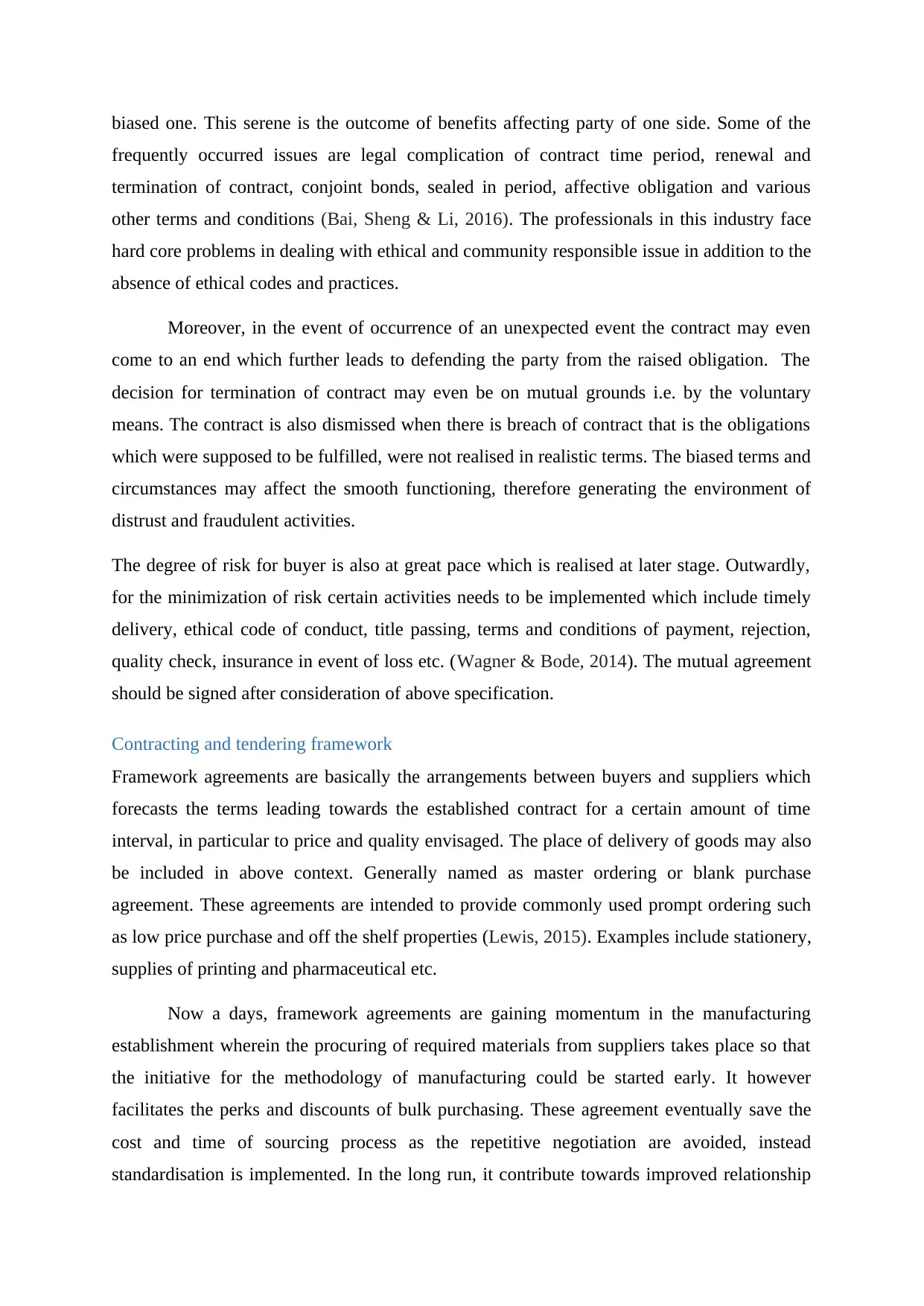
biased one. This serene is the outcome of benefits affecting party of one side. Some of the
frequently occurred issues are legal complication of contract time period, renewal and
termination of contract, conjoint bonds, sealed in period, affective obligation and various
other terms and conditions (Bai, Sheng & Li, 2016). The professionals in this industry face
hard core problems in dealing with ethical and community responsible issue in addition to the
absence of ethical codes and practices.
Moreover, in the event of occurrence of an unexpected event the contract may even
come to an end which further leads to defending the party from the raised obligation. The
decision for termination of contract may even be on mutual grounds i.e. by the voluntary
means. The contract is also dismissed when there is breach of contract that is the obligations
which were supposed to be fulfilled, were not realised in realistic terms. The biased terms and
circumstances may affect the smooth functioning, therefore generating the environment of
distrust and fraudulent activities.
The degree of risk for buyer is also at great pace which is realised at later stage. Outwardly,
for the minimization of risk certain activities needs to be implemented which include timely
delivery, ethical code of conduct, title passing, terms and conditions of payment, rejection,
quality check, insurance in event of loss etc. (Wagner & Bode, 2014). The mutual agreement
should be signed after consideration of above specification.
Contracting and tendering framework
Framework agreements are basically the arrangements between buyers and suppliers which
forecasts the terms leading towards the established contract for a certain amount of time
interval, in particular to price and quality envisaged. The place of delivery of goods may also
be included in above context. Generally named as master ordering or blank purchase
agreement. These agreements are intended to provide commonly used prompt ordering such
as low price purchase and off the shelf properties (Lewis, 2015). Examples include stationery,
supplies of printing and pharmaceutical etc.
Now a days, framework agreements are gaining momentum in the manufacturing
establishment wherein the procuring of required materials from suppliers takes place so that
the initiative for the methodology of manufacturing could be started early. It however
facilitates the perks and discounts of bulk purchasing. These agreement eventually save the
cost and time of sourcing process as the repetitive negotiation are avoided, instead
standardisation is implemented. In the long run, it contribute towards improved relationship
frequently occurred issues are legal complication of contract time period, renewal and
termination of contract, conjoint bonds, sealed in period, affective obligation and various
other terms and conditions (Bai, Sheng & Li, 2016). The professionals in this industry face
hard core problems in dealing with ethical and community responsible issue in addition to the
absence of ethical codes and practices.
Moreover, in the event of occurrence of an unexpected event the contract may even
come to an end which further leads to defending the party from the raised obligation. The
decision for termination of contract may even be on mutual grounds i.e. by the voluntary
means. The contract is also dismissed when there is breach of contract that is the obligations
which were supposed to be fulfilled, were not realised in realistic terms. The biased terms and
circumstances may affect the smooth functioning, therefore generating the environment of
distrust and fraudulent activities.
The degree of risk for buyer is also at great pace which is realised at later stage. Outwardly,
for the minimization of risk certain activities needs to be implemented which include timely
delivery, ethical code of conduct, title passing, terms and conditions of payment, rejection,
quality check, insurance in event of loss etc. (Wagner & Bode, 2014). The mutual agreement
should be signed after consideration of above specification.
Contracting and tendering framework
Framework agreements are basically the arrangements between buyers and suppliers which
forecasts the terms leading towards the established contract for a certain amount of time
interval, in particular to price and quality envisaged. The place of delivery of goods may also
be included in above context. Generally named as master ordering or blank purchase
agreement. These agreements are intended to provide commonly used prompt ordering such
as low price purchase and off the shelf properties (Lewis, 2015). Examples include stationery,
supplies of printing and pharmaceutical etc.
Now a days, framework agreements are gaining momentum in the manufacturing
establishment wherein the procuring of required materials from suppliers takes place so that
the initiative for the methodology of manufacturing could be started early. It however
facilitates the perks and discounts of bulk purchasing. These agreement eventually save the
cost and time of sourcing process as the repetitive negotiation are avoided, instead
standardisation is implemented. In the long run, it contribute towards improved relationship
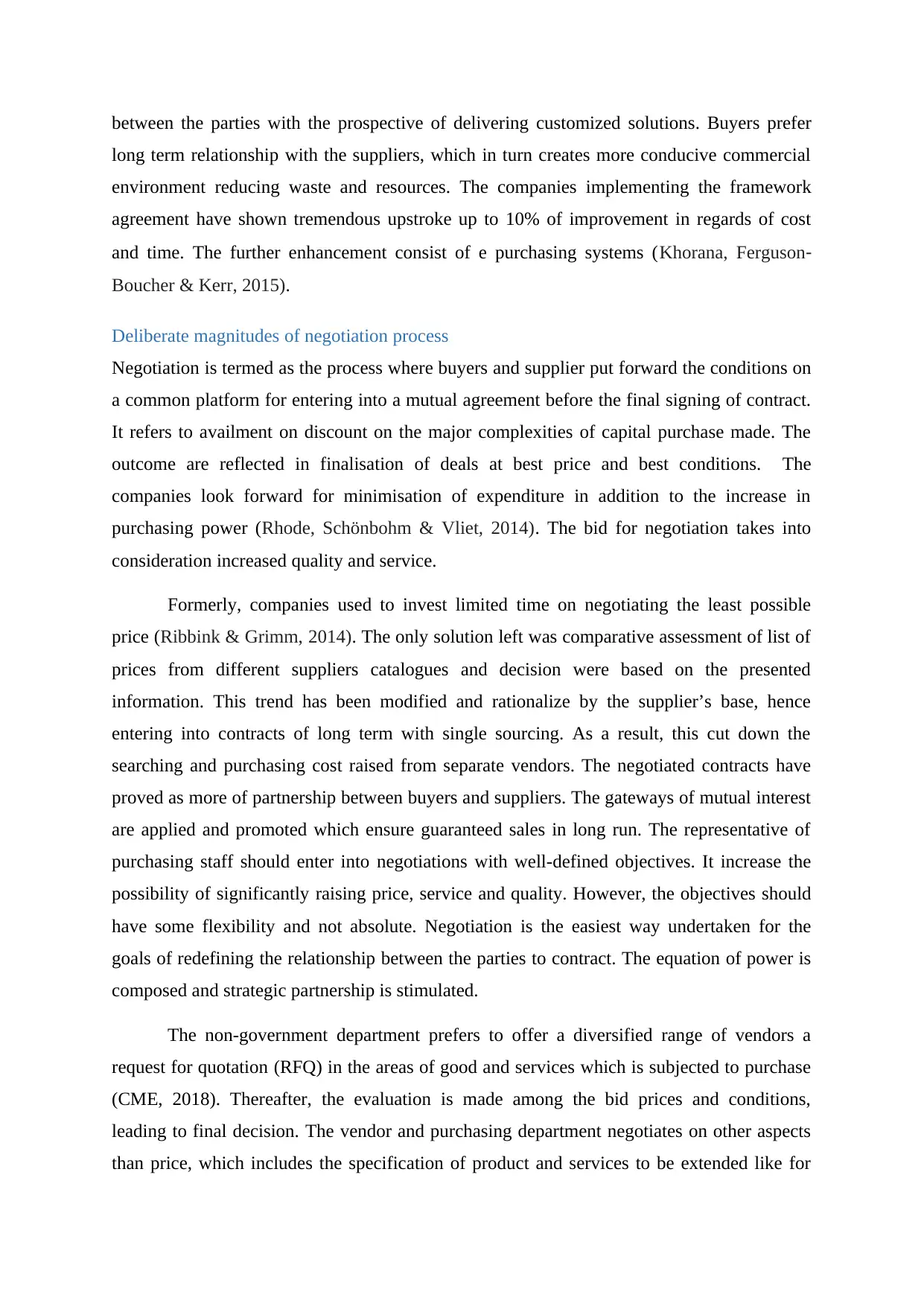
between the parties with the prospective of delivering customized solutions. Buyers prefer
long term relationship with the suppliers, which in turn creates more conducive commercial
environment reducing waste and resources. The companies implementing the framework
agreement have shown tremendous upstroke up to 10% of improvement in regards of cost
and time. The further enhancement consist of e purchasing systems (Khorana, Ferguson‐
Boucher & Kerr, 2015).
Deliberate magnitudes of negotiation process
Negotiation is termed as the process where buyers and supplier put forward the conditions on
a common platform for entering into a mutual agreement before the final signing of contract.
It refers to availment on discount on the major complexities of capital purchase made. The
outcome are reflected in finalisation of deals at best price and best conditions. The
companies look forward for minimisation of expenditure in addition to the increase in
purchasing power (Rhode, Schönbohm & Vliet, 2014). The bid for negotiation takes into
consideration increased quality and service.
Formerly, companies used to invest limited time on negotiating the least possible
price (Ribbink & Grimm, 2014). The only solution left was comparative assessment of list of
prices from different suppliers catalogues and decision were based on the presented
information. This trend has been modified and rationalize by the supplier’s base, hence
entering into contracts of long term with single sourcing. As a result, this cut down the
searching and purchasing cost raised from separate vendors. The negotiated contracts have
proved as more of partnership between buyers and suppliers. The gateways of mutual interest
are applied and promoted which ensure guaranteed sales in long run. The representative of
purchasing staff should enter into negotiations with well-defined objectives. It increase the
possibility of significantly raising price, service and quality. However, the objectives should
have some flexibility and not absolute. Negotiation is the easiest way undertaken for the
goals of redefining the relationship between the parties to contract. The equation of power is
composed and strategic partnership is stimulated.
The non-government department prefers to offer a diversified range of vendors a
request for quotation (RFQ) in the areas of good and services which is subjected to purchase
(CME, 2018). Thereafter, the evaluation is made among the bid prices and conditions,
leading to final decision. The vendor and purchasing department negotiates on other aspects
than price, which includes the specification of product and services to be extended like for
long term relationship with the suppliers, which in turn creates more conducive commercial
environment reducing waste and resources. The companies implementing the framework
agreement have shown tremendous upstroke up to 10% of improvement in regards of cost
and time. The further enhancement consist of e purchasing systems (Khorana, Ferguson‐
Boucher & Kerr, 2015).
Deliberate magnitudes of negotiation process
Negotiation is termed as the process where buyers and supplier put forward the conditions on
a common platform for entering into a mutual agreement before the final signing of contract.
It refers to availment on discount on the major complexities of capital purchase made. The
outcome are reflected in finalisation of deals at best price and best conditions. The
companies look forward for minimisation of expenditure in addition to the increase in
purchasing power (Rhode, Schönbohm & Vliet, 2014). The bid for negotiation takes into
consideration increased quality and service.
Formerly, companies used to invest limited time on negotiating the least possible
price (Ribbink & Grimm, 2014). The only solution left was comparative assessment of list of
prices from different suppliers catalogues and decision were based on the presented
information. This trend has been modified and rationalize by the supplier’s base, hence
entering into contracts of long term with single sourcing. As a result, this cut down the
searching and purchasing cost raised from separate vendors. The negotiated contracts have
proved as more of partnership between buyers and suppliers. The gateways of mutual interest
are applied and promoted which ensure guaranteed sales in long run. The representative of
purchasing staff should enter into negotiations with well-defined objectives. It increase the
possibility of significantly raising price, service and quality. However, the objectives should
have some flexibility and not absolute. Negotiation is the easiest way undertaken for the
goals of redefining the relationship between the parties to contract. The equation of power is
composed and strategic partnership is stimulated.
The non-government department prefers to offer a diversified range of vendors a
request for quotation (RFQ) in the areas of good and services which is subjected to purchase
(CME, 2018). Thereafter, the evaluation is made among the bid prices and conditions,
leading to final decision. The vendor and purchasing department negotiates on other aspects
than price, which includes the specification of product and services to be extended like for
⊘ This is a preview!⊘
Do you want full access?
Subscribe today to unlock all pages.

Trusted by 1+ million students worldwide
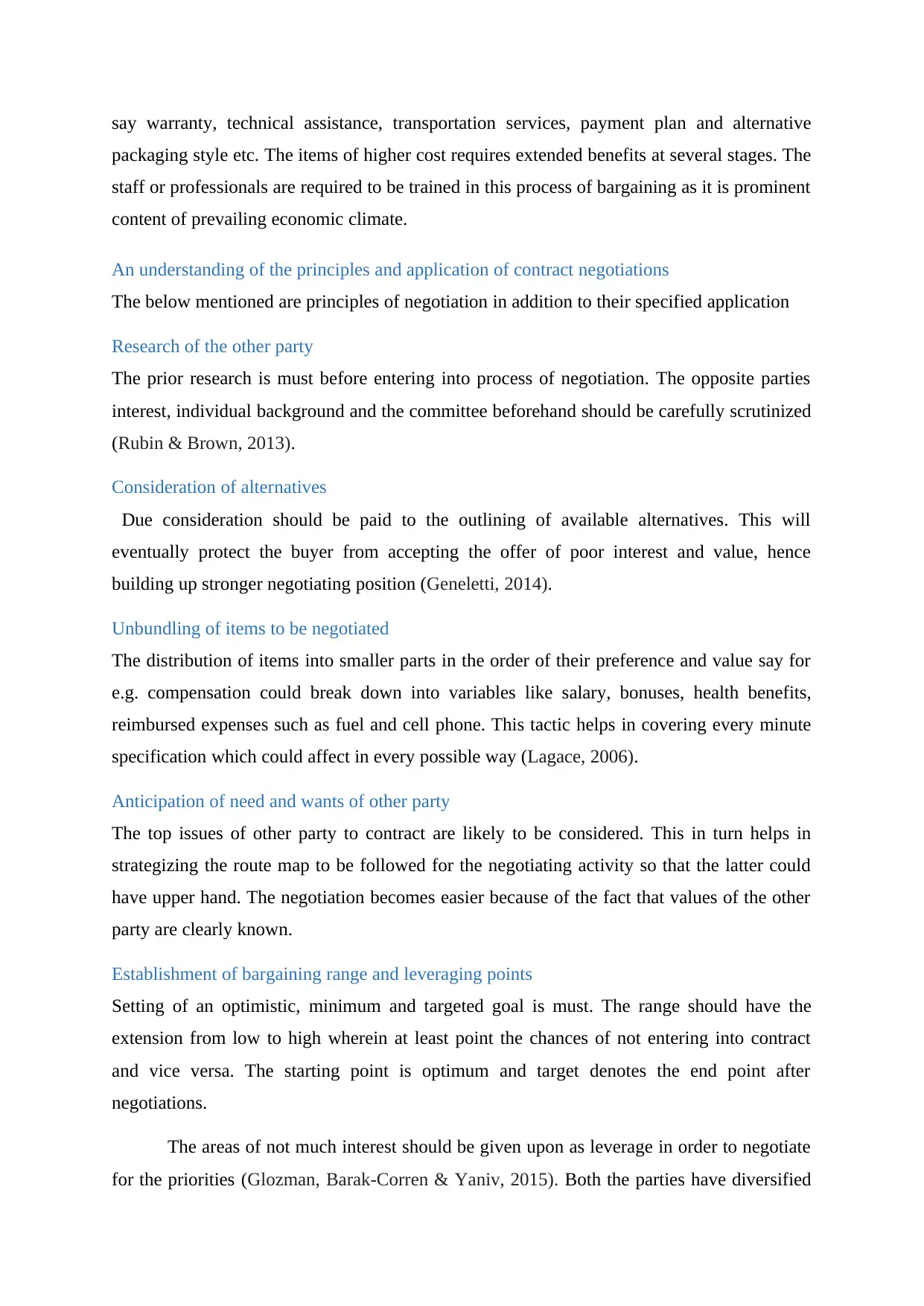
say warranty, technical assistance, transportation services, payment plan and alternative
packaging style etc. The items of higher cost requires extended benefits at several stages. The
staff or professionals are required to be trained in this process of bargaining as it is prominent
content of prevailing economic climate.
An understanding of the principles and application of contract negotiations
The below mentioned are principles of negotiation in addition to their specified application
Research of the other party
The prior research is must before entering into process of negotiation. The opposite parties
interest, individual background and the committee beforehand should be carefully scrutinized
(Rubin & Brown, 2013).
Consideration of alternatives
Due consideration should be paid to the outlining of available alternatives. This will
eventually protect the buyer from accepting the offer of poor interest and value, hence
building up stronger negotiating position (Geneletti, 2014).
Unbundling of items to be negotiated
The distribution of items into smaller parts in the order of their preference and value say for
e.g. compensation could break down into variables like salary, bonuses, health benefits,
reimbursed expenses such as fuel and cell phone. This tactic helps in covering every minute
specification which could affect in every possible way (Lagace, 2006).
Anticipation of need and wants of other party
The top issues of other party to contract are likely to be considered. This in turn helps in
strategizing the route map to be followed for the negotiating activity so that the latter could
have upper hand. The negotiation becomes easier because of the fact that values of the other
party are clearly known.
Establishment of bargaining range and leveraging points
Setting of an optimistic, minimum and targeted goal is must. The range should have the
extension from low to high wherein at least point the chances of not entering into contract
and vice versa. The starting point is optimum and target denotes the end point after
negotiations.
The areas of not much interest should be given upon as leverage in order to negotiate
for the priorities (Glozman, Barak-Corren & Yaniv, 2015). Both the parties have diversified
packaging style etc. The items of higher cost requires extended benefits at several stages. The
staff or professionals are required to be trained in this process of bargaining as it is prominent
content of prevailing economic climate.
An understanding of the principles and application of contract negotiations
The below mentioned are principles of negotiation in addition to their specified application
Research of the other party
The prior research is must before entering into process of negotiation. The opposite parties
interest, individual background and the committee beforehand should be carefully scrutinized
(Rubin & Brown, 2013).
Consideration of alternatives
Due consideration should be paid to the outlining of available alternatives. This will
eventually protect the buyer from accepting the offer of poor interest and value, hence
building up stronger negotiating position (Geneletti, 2014).
Unbundling of items to be negotiated
The distribution of items into smaller parts in the order of their preference and value say for
e.g. compensation could break down into variables like salary, bonuses, health benefits,
reimbursed expenses such as fuel and cell phone. This tactic helps in covering every minute
specification which could affect in every possible way (Lagace, 2006).
Anticipation of need and wants of other party
The top issues of other party to contract are likely to be considered. This in turn helps in
strategizing the route map to be followed for the negotiating activity so that the latter could
have upper hand. The negotiation becomes easier because of the fact that values of the other
party are clearly known.
Establishment of bargaining range and leveraging points
Setting of an optimistic, minimum and targeted goal is must. The range should have the
extension from low to high wherein at least point the chances of not entering into contract
and vice versa. The starting point is optimum and target denotes the end point after
negotiations.
The areas of not much interest should be given upon as leverage in order to negotiate
for the priorities (Glozman, Barak-Corren & Yaniv, 2015). Both the parties have diversified
Paraphrase This Document
Need a fresh take? Get an instant paraphrase of this document with our AI Paraphraser
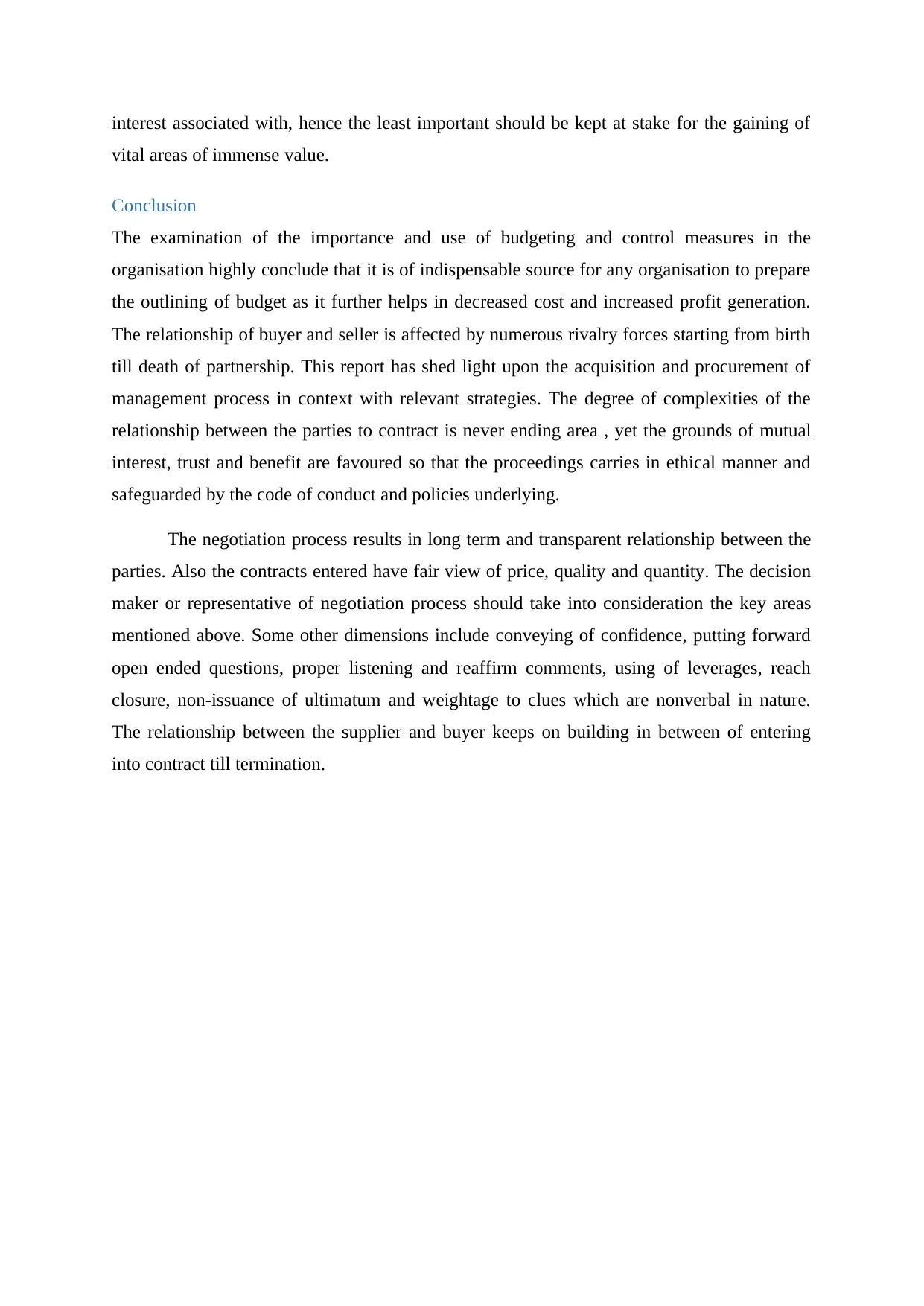
interest associated with, hence the least important should be kept at stake for the gaining of
vital areas of immense value.
Conclusion
The examination of the importance and use of budgeting and control measures in the
organisation highly conclude that it is of indispensable source for any organisation to prepare
the outlining of budget as it further helps in decreased cost and increased profit generation.
The relationship of buyer and seller is affected by numerous rivalry forces starting from birth
till death of partnership. This report has shed light upon the acquisition and procurement of
management process in context with relevant strategies. The degree of complexities of the
relationship between the parties to contract is never ending area , yet the grounds of mutual
interest, trust and benefit are favoured so that the proceedings carries in ethical manner and
safeguarded by the code of conduct and policies underlying.
The negotiation process results in long term and transparent relationship between the
parties. Also the contracts entered have fair view of price, quality and quantity. The decision
maker or representative of negotiation process should take into consideration the key areas
mentioned above. Some other dimensions include conveying of confidence, putting forward
open ended questions, proper listening and reaffirm comments, using of leverages, reach
closure, non-issuance of ultimatum and weightage to clues which are nonverbal in nature.
The relationship between the supplier and buyer keeps on building in between of entering
into contract till termination.
vital areas of immense value.
Conclusion
The examination of the importance and use of budgeting and control measures in the
organisation highly conclude that it is of indispensable source for any organisation to prepare
the outlining of budget as it further helps in decreased cost and increased profit generation.
The relationship of buyer and seller is affected by numerous rivalry forces starting from birth
till death of partnership. This report has shed light upon the acquisition and procurement of
management process in context with relevant strategies. The degree of complexities of the
relationship between the parties to contract is never ending area , yet the grounds of mutual
interest, trust and benefit are favoured so that the proceedings carries in ethical manner and
safeguarded by the code of conduct and policies underlying.
The negotiation process results in long term and transparent relationship between the
parties. Also the contracts entered have fair view of price, quality and quantity. The decision
maker or representative of negotiation process should take into consideration the key areas
mentioned above. Some other dimensions include conveying of confidence, putting forward
open ended questions, proper listening and reaffirm comments, using of leverages, reach
closure, non-issuance of ultimatum and weightage to clues which are nonverbal in nature.
The relationship between the supplier and buyer keeps on building in between of entering
into contract till termination.
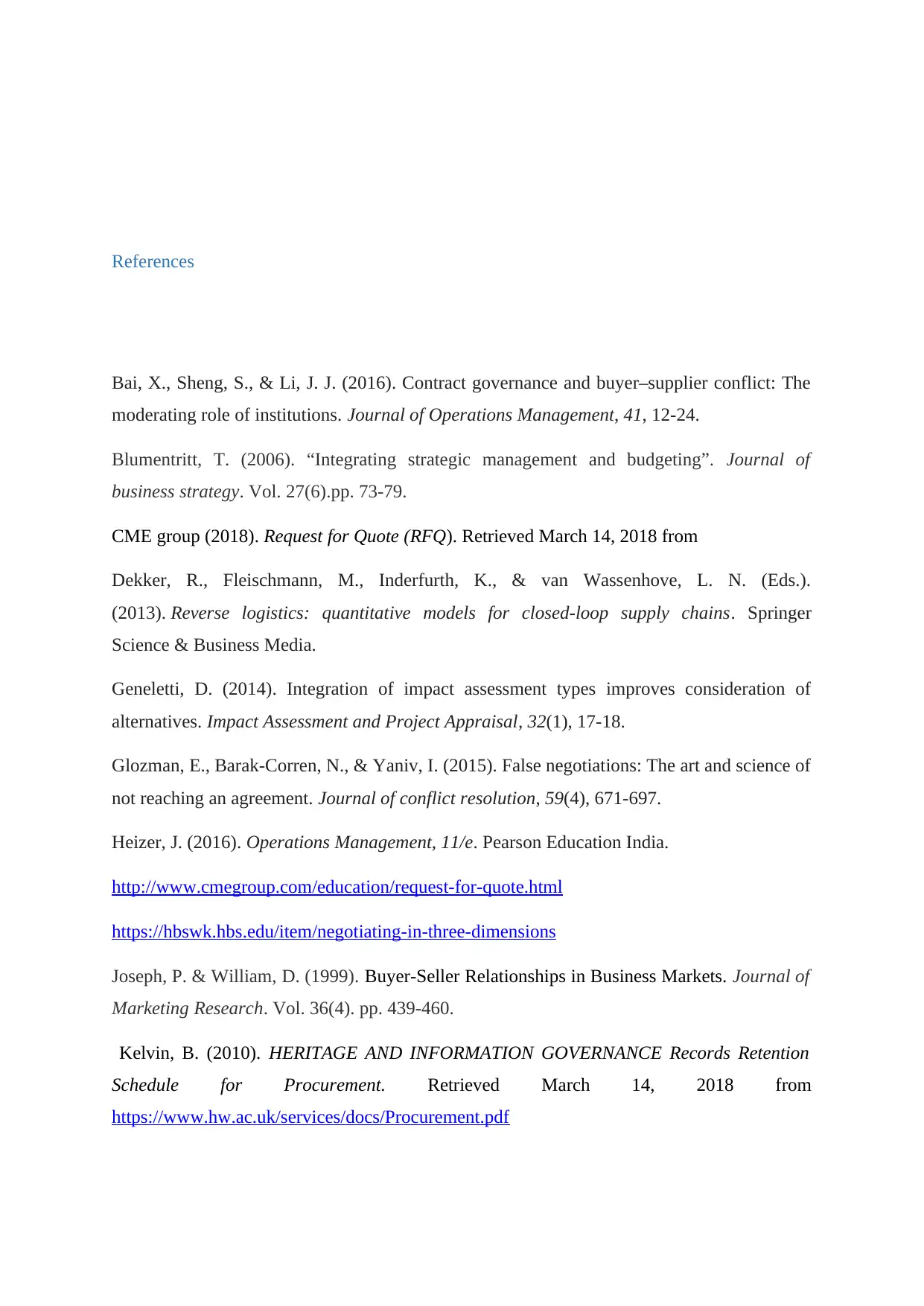
References
Bai, X., Sheng, S., & Li, J. J. (2016). Contract governance and buyer–supplier conflict: The
moderating role of institutions. Journal of Operations Management, 41, 12-24.
Blumentritt, T. (2006). “Integrating strategic management and budgeting”. Journal of
business strategy. Vol. 27(6).pp. 73-79.
CME group (2018). Request for Quote (RFQ). Retrieved March 14, 2018 from
Dekker, R., Fleischmann, M., Inderfurth, K., & van Wassenhove, L. N. (Eds.).
(2013). Reverse logistics: quantitative models for closed-loop supply chains. Springer
Science & Business Media.
Geneletti, D. (2014). Integration of impact assessment types improves consideration of
alternatives. Impact Assessment and Project Appraisal, 32(1), 17-18.
Glozman, E., Barak-Corren, N., & Yaniv, I. (2015). False negotiations: The art and science of
not reaching an agreement. Journal of conflict resolution, 59(4), 671-697.
Heizer, J. (2016). Operations Management, 11/e. Pearson Education India.
http://www.cmegroup.com/education/request-for-quote.html
https://hbswk.hbs.edu/item/negotiating-in-three-dimensions
Joseph, P. & William, D. (1999). Buyer-Seller Relationships in Business Markets. Journal of
Marketing Research. Vol. 36(4). pp. 439-460.
Kelvin, B. (2010). HERITAGE AND INFORMATION GOVERNANCE Records Retention
Schedule for Procurement. Retrieved March 14, 2018 from
https://www.hw.ac.uk/services/docs/Procurement.pdf
Bai, X., Sheng, S., & Li, J. J. (2016). Contract governance and buyer–supplier conflict: The
moderating role of institutions. Journal of Operations Management, 41, 12-24.
Blumentritt, T. (2006). “Integrating strategic management and budgeting”. Journal of
business strategy. Vol. 27(6).pp. 73-79.
CME group (2018). Request for Quote (RFQ). Retrieved March 14, 2018 from
Dekker, R., Fleischmann, M., Inderfurth, K., & van Wassenhove, L. N. (Eds.).
(2013). Reverse logistics: quantitative models for closed-loop supply chains. Springer
Science & Business Media.
Geneletti, D. (2014). Integration of impact assessment types improves consideration of
alternatives. Impact Assessment and Project Appraisal, 32(1), 17-18.
Glozman, E., Barak-Corren, N., & Yaniv, I. (2015). False negotiations: The art and science of
not reaching an agreement. Journal of conflict resolution, 59(4), 671-697.
Heizer, J. (2016). Operations Management, 11/e. Pearson Education India.
http://www.cmegroup.com/education/request-for-quote.html
https://hbswk.hbs.edu/item/negotiating-in-three-dimensions
Joseph, P. & William, D. (1999). Buyer-Seller Relationships in Business Markets. Journal of
Marketing Research. Vol. 36(4). pp. 439-460.
Kelvin, B. (2010). HERITAGE AND INFORMATION GOVERNANCE Records Retention
Schedule for Procurement. Retrieved March 14, 2018 from
https://www.hw.ac.uk/services/docs/Procurement.pdf
⊘ This is a preview!⊘
Do you want full access?
Subscribe today to unlock all pages.

Trusted by 1+ million students worldwide
1 out of 14
Related Documents
Your All-in-One AI-Powered Toolkit for Academic Success.
+13062052269
info@desklib.com
Available 24*7 on WhatsApp / Email
![[object Object]](/_next/static/media/star-bottom.7253800d.svg)
Unlock your academic potential
Copyright © 2020–2025 A2Z Services. All Rights Reserved. Developed and managed by ZUCOL.




